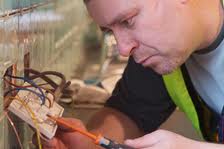Electricians: When to Call Them for Help

We are living in a world wherein we want to do things by ourselves to avoid further cost of hiring someone to do some professional work that we have basic background how to. However, tinkering with electrical installations shall be an exception, and should be referred to electricians. On what situations would you need to have an electrician?
Call them when your sockets already start not to function. There may be faults or misconfiguration in the electrical wiring system on your structure that needs immediate attention. They can figure out the faults in the system by isolating parts of the installation one by one. They would then advise you what should be replaced or repaired.
You shall also call them when your structure was ravaged by natural calamities such as severe flooding. Flooding may cause electric sockets to be grounded, and may cause the whole installation to bog down once electricity is back due to exposure to water.
They are also needed when the fuse already starts to trip. This problem is most likely linked to the first situation mentioned above, since they are connected on circuits.
When telephone and DSL lines are not working, electricians may also be needed. Some telephone installations are near high-voltage electric lines, which may disrupt normal operations of the telephone system, including the high-speed internet access via DSL, which is still hooked to the copper-wired telephone. Distancing the phone line from electricity cables shall improve call quality and may improve speeds and latency. The same goes on to the intercom and doorbell systems.
If you are to do anything more than just replacing light bulbs and/or electrical appliances, you may need to call expert help. This ensures that anything you may want to do with the connections must be compatible with your existing system, and if needed, can be adjusted to accommodate new electrical connections.
When you need to sell a structure or put it into sale, the clearance from electricians must be first sought. This is to clear you of any liability of putting the next owner into permanent danger and also give an assurance to the new owner that the structure’s electrical system is at a good state.